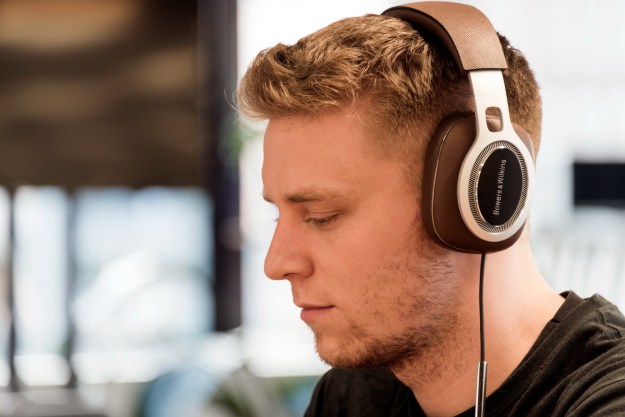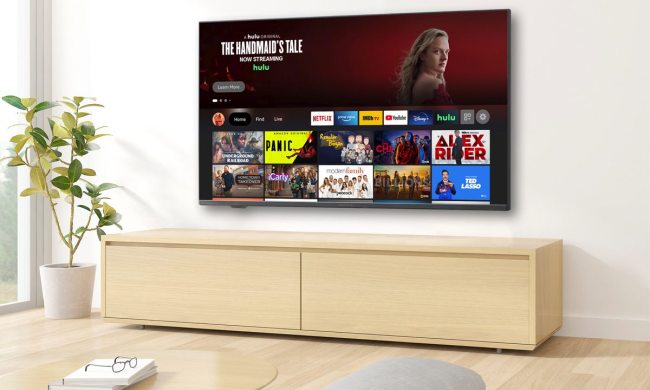
“Like a supercar, the bass-ey P9 are fun to take out on the track, but they’re not practical for most of us.”
- Gorgeous and accurate upper register
- Rich and powerful midrange
- Sleek and stylish design
- Robust build quality
- Luscious bass response
- Bass is often overpowering
- Tight clamping force
Bass lovers, your time is now. You can thank Beats for encouraging the teems of bass-boosted headphones on the market today.
It seems no company is immune to this trend, including long-standing high-end audio brand Bowers & Wilkins (aka B&W). Many of B&W’s P-series headphones have gotten a bass-head overhaul as of late, but the pinnacle comes in the form of the new $900 P9 Signature (that’s right, $900). Created as part of Bowers & Wilkins’ 50th anniversary celebration, the P9 may well be the first headphones to attempt to appeal to both bass lovers and their presumed mortal enemies, hardcore audiophiles. The result is an enigmatic sonic signature that thrills as easily as it bombards you with boom, for a sound unlike anything else we’ve heard in headphone land.
Out of the box
As part of the celebration for its 50th anniversary, B&W spared no expense when it comes to the P9’s design, but the unboxing experience isn’t quite as striking. A heavy-gauge white box pulls away to reveal the P9 folded in on themselves and resting in a custom-cut inlay.
While the packaging isn’t much, the executive-style headphones make an impression right away. The brown leather of the model we received adds a touch of ‘70s flair to the oversized earpieces and silky-smooth padding, while traces of inlaid chrome sparkle satisfyingly against the matte-silver band.
Beneath the headphones lay three removable cables — one with a three-button iOS control mic – and a semi-circular soft case covered in faux suede.
Features and design
The P9 carry the chic styling of the rest of the P-series, offering design accents that give the look and feel of a luxury device, but without gaudy frills. It’s an interesting break from the so-called “urban styling” found with so many other bass-forward headphones. Then again, we’d expect nothing less from Bowers and Wilkins.
While subtlety leads the design theme, giving the P9 a closer look reveals some intriguing elements added both for aesthetic appeal and serious sonic performance. The matte-finished headband is a study in minimalism, with arms that slide smoothly to fit and buckle inward on sturdy hinges for better portability. Where the band meets the earpieces, a brilliant design trait is revealed in the form of a spongy material acting as a suspension for the Bowers and Wilkins logos, holding the earcups in place while decoupling them from the headband to prevent unwanted vibration and reduce distortion.
The P9 sound fantastic rendering high resolution tracks mixed with restraint in the bass.
At the exterior of each earcup is our least favorite material on the P9, in the form of a hard Saffiano shell with crisscrossed dimples, which is replicated above at the top of the headband. The healthy coating of supple leather on the pads makes up for it, though. Like the P7, the pads are magnetically attached, allowing them to easily be removed and replaced. This is also where the removable cable attaches to the right earcup.
Pulling away the earpads reveals the drivers within, which are set at an angle to create a “more natural stereo experience.” While the P9’s dimensional soundstage is impressive, it’s worth noting many headphones in this price range opt for an open-backed design, generally making for bigger, more open sound. Instead, the company says it used Finite Element Analysis to craft an acoustic cabinet from composites and aluminum that is optimized for the drivers. The drivers themselves are purpose built for the P9 using what B&W calls a “custom suspension system” for precision at higher frequencies and “great bass.”
Comfort
One of our initial gripes about the P9 was their excessive clamping force, which was extremely uncomfortable for the first few days. Like a good pair of boots, however, the band seemed to wear in over time making them tolerable for daily use. Still, we wished for more relief from the earcups and less weight. We still find Audeze’s comparably priced EL-8 headphones far more comfy.
Performance
We tested the P9 using a wide range of musical styles, file types and resolutions. Hardware used in this review included an Antelope Zodiac DAC/headphone amp, an Astell & Kern AK Jr. high-resolution audio player, an iPhone, and a Macbook. We also compared the headphones to several different high-end models, including two pairs of planar magnetic cans from Audeze (the $800 EL-8 open-back
As a painstakingly crafted flagship headphone from a major name in audio, there’s a lot going on with the P9’s sound signature — so much that it takes several days to explore all its nooks and crannies. But the overlying factor that shapes every sound element is the fact that the P9 have approximately double the audible bass of every other high-end headphone we pitted them against. And there’s no doubt that doubling the bass has a serious impact on virtually everything you listen to.
We started our evaluation with one of our most familiar rock playlists on Spotify, which, frankly, often had us perplexed about just what we were hearing. You could say these headphones are a bass lover’s dream, and by bass in this example, we mean bass guitar. While each headphone has its own sonic flavor, most premium
Many songs end up with barreling bass solos that weren’t supposed to be solos.
In some songs, this creates a claustrophobic effect — there’s only so much room in a mix after all — which crowds the center image, pushing it well into the front and washing out some of the presence in lead vocals. From Billy Joel’s The Entertainer to Radiohead’s Nude, we heard barreling bass solos that weren’t supposed to be solos, and crashing waves of percussion that get more of the spotlight than they’re afforded by virtually every other high-end headphone we’ve heard. The effect adds some excitement, no doubt, but it also creates an alien mix that breaks away from how the song was originally mixed and mastered.
Unlike most other bass blasters we’ve heard, however, there’s much more to the story here. The P9 are as talented and capable in the midrange and treble as any other headphone in their price range. Even when bass is overpowering, that kind of precision provides clear-cut instrumental placement, especially in the far reaches of the stereo channels, as well as rich and textured detail, exposing the complex timbres of instruments like mandolin, brass, and electric guitar. When uncluttered by heavy bass, the P9’s dimensional soundstage also allows you to dive deep into its many layers to explore each instrument in space.
The P9 sound fantastic rendering high resolution tracks mixed with restraint down low, such as Steely Dan’s Babylon Sisters. Here, the high-powered bass melts away to reveal flowing textures in each instrument, from the reedy breaths of a saxophone to the papery depths of the snare drum head. There’s a darker flavor in the midrange than what’s delivered from the EL-8, for instance, but there’s also some vibrancy that’s not present in the EL-8’s flatter sound, creating a driving punch in the percussion. We had a similar experience with Muse’s Black Holes and Revelations, in which the groove was accentuated for a sonic experience that feels less like the drier studio delivery, and more like the band’s extravagant live shows.
Moving to hip-hop is more of a hit-or-miss affair, even from song to song on the same album. Kendrick Lamar’s Wesley’s Theory, for instance, was enthralling from the get-go, with the crispy clicks of the fake vinyl effect crackling in space so clearly, we could almost see each tiny divot as the stylus traced the groove. King Kuntu started with similar excitement — vocals and upper percussion shone like the sterling chrome that adorns the P9’s earpieces, cut in striking detail. But over time, the driving beat simply became too onerous, wearing out our eardrums with its relentless drone.
Our Take
The P9 are capable of amazing moments, but their propensity to overpower elements with overwhelming bass in some of our favorite songs is tough to justify for a pair of headphones that cost just under $1,000. When we listen to a pair of top-tier cans we expect everything we audition to sound better, with the possible exception of lo-fi MP3s. There’s no shortage of bassheads out there searching for low-end nirvana, but we’re not sure there are many willing to pay $900 for the privilege of finding it.
How long will it last?
When it comes to build quality, the P9 are second to none at their price point. Carefully crafted from high quality components, we expect them to last as long as you want them around.
What are the alternatives?
For those looking for balanced, detailed sound, we’d recommend each of the headphones mentioned earlier in this review, including the affordable HD 6XX. For those looking for powerful bass as a determining factor, we recommend checking out V-Moda’s Crossfade M100, as well as Sennheiser’s Urbanites, both of which bring plenty of boom, while keeping things in check.
Should you buy it?
For the majority of listeners, the answer is no. As we alluded to above, we’re just not sure who these headphones are meant for — audiophiles will all but assuredly choose a flatter sound, while those looking for a bassier mix likely aren’t looking to pay $900. Due to their limited applications, the P9 feel like the headphone equivalent of a race car that gets 6 miles to the gallon and doesn’t have air conditioning; it’s fun to take it out on the track, but it’s simply not a practical purchase for most of us.







